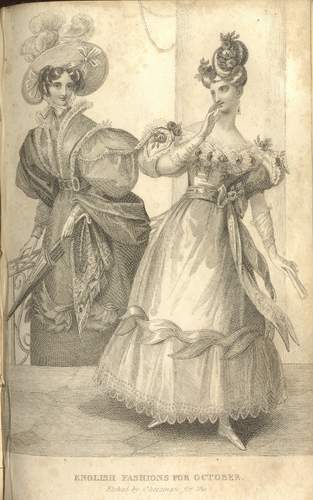
Plate 1, Fig. 1.
A ball dress of white gaze d'Inde, splendidly painted in natural colours, worn over a slip of white, or very pale pink satin. The corsage is made in a novel and becoming style, and displays a fine figure to great advantage. The front is cut rather low, and is ornamented with an elegant stomacher and shoulder-bands, painted to correspond with the bottom of the skirt. The stomacher is cut to let the band pass through, near the top, from whence they are continued to the ceinture, where they meet under an embossed clasp of massive gold. The back is made to match the front. A short full sleeve, with very little in the way of trimming, finishes this chaste and beautiful body. The skirt has a light and simple garniture of bias cut pieces, placed en revers, and surmounted by a rich border composed of bouquets of Provence roses, with their buds and foliage. The hair is dressed high, and is arranged in three full bows on the summit of the heat. The front hair is disposed in large boucles on the temples. A bandeau of large pearls is placed transversely on the forehead, and is passed over the back of the head, and crosses the insertion of a very high comb, the points of which are seen above the whole head-dress. Necklace, earrings and bracelets of pearls and diamonds. Gloves and shoes of white satin.
Fig. 2.
Evening dress of crape, colour of a light shade of azure blue, over satin of the same tint. The skirt is of a moderate length, and not too full. It has a deep flounce, composed of separate parts, cut in such as way as to form a succession of full points, which fall over each other at the bottom, while the top of each portion is reversed inwardly, giving a very pretty heading of broad tongue-shaped leaves. The body is made full across the bust, forming a drapery a la Sevigne at the upper part; confined towards the waist by four indented bands, decreasing in size as they descend. A full bow of satin is placed in the center at the top of the front. The sleeve is very full, and has a guirlande of vine-leaves, of satin, placed en feston, across the top. Bows of satin, like that in front, finish the shoulders and the centre of the back. Ceinture of satin. An elegant coiffure completes this dress. Te front hair is parted across the forehead in the Madonna style, the ends of which fall in soft negligent ringlets at the back of the neck. The back hair is plaited en corbeille at the top, or rather inclined to one side of the head, the plait rising on one side, and falling very gracefully on the other in a very novel manner. Small white Persian roses, a gold chain and jewels, a la Ferroniere, and a richly inlaid comb of tortoise-shell and gold finishes this very tasteful coiffure.-Neck-chain and cross of coloured gold; shoes of black satin.
Plate 2, Fig. 3.
Carriage or promenade dress of the king's or naval blue, figured gros de Tours. The corsage is made uni, and cut square across the bust. A canezou of white net, with a double standing collar and deep epaulettes, trimmed with quills, is worn with this dress. The sleeve is very large at the top, and as far as the elbow, but the lower sleeve is quite close to the arm, and is covered with a reticulation of corded bands, in a new and striking style. The skirt is made very full, and with a deep hem, above which is a trimming of deeply vandyked leaves, folded and disposed so that the narrow ends of the leaves rise in acute points from the lance-shaped straps of which connect them with each other. Ha of paille de Toscane. The front is made very open, and has four bows of white gauze ribbon on the right side, close to the temple; three similar bows are set nearly at the outer edge of the left side, from which two bands extend to the back part of the brim. The crown is inclined forwards, and is surmounted by a rich plume of feathers, intermingled with bows of gauze ribbon. Mentionneieres of British thread-lace. Gloves of lemon-coloured kid. Shoes of blue silk
Fig. 4.
Ball dress. Dress of rich white satin. the body is plain, with a full ruche of blonde and roses, at the top. The blonde is disposed en eventail, and each fan partially displays a half-blown rose, the foliage of which is laid close to the body of the dress, pointing downward to the waist. The short sleeve has the fulness set in a plain band at the bottom; the upper part has an ornament cut in the corm of a heart, and turned over with the narrow part towards the elbow, the broad part forming a recess for a small bunch or roses. The skirt has a deep fall of blonde set on alternately, full and plain, and finished at the top with a double row of tulip-leaves, placed partly on the blonde, and partly on the skirt, in a unique style. A circassian sash, of white and silver gauze ribbon, is tied in a bow on the left side, with long ends, deeply cut, reaching nearly to the bottom of the dress. A small bouquet of roses is tied up with the bow of the sash. The hair is arrange din two large coques at the top, between which is placed a demi-wreath of roses and silver foliage. The front hair is parted in the centre, and disposed in a full coque on each side of the forehead; in that on the right side is placed a rose. Earrings, Ferroniere, and bracelets of pearls and pink topaz. Gloves of white kid. Shoes of white satin, with silver sandals.
|
 Home now, please!
Home now, please!